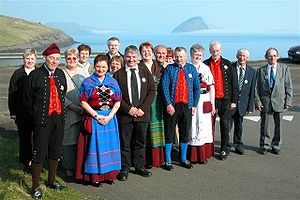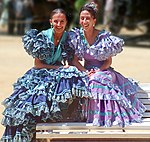Folk costume

Folk costume (also regional costume, national costume, or traditional garments) expresses an identity through costume which is usually associated with a geographic area or a period of time in history, but can also indicate social, marital and/or religious status. Such costumes often come in two forms: one for everyday occasions, the other for festivals and formal wear.
Following the outbreak of romantic nationalism, the peasantry of Europe came to serve as models for all that appeared genuine and desirable. Their dress crystallised into so-called "typical" forms, and enthusiasts adopted it as part of their symbolism.
In areas where contemporary Western fashions have become usual, traditional garments are often worn at special events or celebrations, particularly those connected with cultural traditions, heritage, or pride.
In modern times there are instances where traditional garments are required by law, as in Bhutan, where the traditional Tibetan-style clothing of gho and kera for men, kira and toego for women, must be worn by all citizens—even those not of Tibetan heritage; or in Saudi Arabia, where women are required to wear the abaya in public.
Africa

West Africa
- Benin - lace Dashiki suit and Aso Oke Hat (male), lace Buba and wrapper set (female)
- Ghana - Kente cloth, Ghanaian smock, and Fila (male), Kente buba and skirt set and Kaftan (female)
- Liberia - Dashiki suit cats Kufi (male), Buba and skirt set, Buba and wrapper set, and Kaftan (female)
- Mali - Grand boubou and Kufi (male), Kaftan (female)
- Nigeria - Agbada and Isiagu (male), Buba and wrapper set (female), Fila, Aso Oke Hat
- Senegal - Senegalese kaftan and Kufi (male), Kaftan (female)
North Africa
- Egypt - Galabeya
- Morocco - Djellaba (male), Fez hat, Takchita (female)
- Sudan - Jalabiyyah, Taqiyyah, and Turban (male), Toob, a cotton women's dress (female)
Horn of Africa
- Ethiopia - Ethiopian suit (male), Ethiopian coffee dress (female)
- Somalia - Macawiis (male), Koofiyad (male), Jilbab (female), Dirac[disambiguation needed] (female)
East Africa
- Kenya - Dashiki, Kanzu, and Kofia (male), Kanga and Kitenge (female)
- Rwanda - Kanzu (male), Mushanana (female)
- Tanzania - Kanzu, Dashiki, and Kofia (male), Kanga and Gowni (female)
- Uganda - Kanzu, Dashiki, and Kofia (male), Gomesi (female)
Southern Africa
- South Africa - Afrikaners, Anglo-Africans: Slouch Hat, Bermuda shorts, khaki; Zulus, Xhosa, etc.: Madiba shirt, Dashiki, Zulu crown (isicholo)
- Zimbabwe - Safari shirt and Dashiki (male), Buba and skirt set (female)
Americas

- Brazil - Each region has its own traditional costume
- Canada - Tuque, Anorak, Ceinture fléchée, Lumberjack uniform, Red Serge
- Chile - Huaso costume
- Colombia - Sombrero Vueltiao, ruana, white shirt, trousers and espadrilles (male), Sombrero Vueltiao, blouse, pollera and espadrilles (female)
- Cuba - Guayabera, Khaki pants, Panama hat or Fedora (male), Guayabera dress (female)
- Dominican Republic - Chacabana
- Guatemala - Huipil, Corte skirt, Tocado, Todosantero suit.
- Guyana - Shirt jacket (male), Booboo (female)
- Haiti - Karabela dress (female), Shirt jacket (male)
- Jamaica - Bandana skirt and peasant blouse (female), Bush jacket (male)
- Mexico - Charro suit, Guayabera, Huipil, Mariachi suit, Rebozo, Sarape, Sombrero
- Panama - Pollera
- Peru - Chullo, Poncho
- Puerto Rico - Guayabera, Pantalons, and Panama hat (male), Trajes (dress) (Female)
- St. Lucia - Madras dress (female)
- Trinidad - Shirt-jac (male), Booboo (female) and Carnival costumes
- United States - Various forms of Native American clothing. Western wear derived from original American pioneer garb is traditional dress in Texas, the Southwest, and many rural communities, including Cowboy Hats, Western shirts, boots, jeans, prairie skirts, and bolo ties. Traditional Southern wear includes white seersucker suits and string ties for men, and sun hats and large dresses for women. Patriotic historic American costume, especially in the East, includes clothing styles of the Plymouth Pilgrims, Founding Fathers of the United States, William Penn, or Minutemen. Summer residents of Nantucket will often wear Nantucket Reds. Amish and some sects of Mormon fundamentalism preserve traditional 19th century clothing styles for those groups.
- Venezuela - Liqui liqui, pelo e' guama hat.
Asia
Central Asia
East Asia

- China - Hanfu (Han Chinese),tangzhuang (the whole country)
- Japan - Kimono
- Korea - Hanbok
- Mongolia - Deel
South Asia
- Bangladesh - Sarong, long sleeved white shirt (male) and Sari (female)
- Sri Lanka - Dhoti and Lungi, Sarong, Sari
- Maldives - Dhivehi libaas (women) Sarong, long sleeved white shirt (men)
- Bhutan - Gho (male) and Kira (female)
- Nepal - Daura-Suruwal, (male) and Gunyou Cholo (female)
- Pakistan - Sherwani, Shalwar Kameez
- India - Nehru suit, Achkan, Dhoti, Kurta (male) and Sari (female), Shalwar Kameez, Khara Dupatta, Makhela-Chadar (in Assam) (female)
Southeast Asia and Pacific

- Brunei - Baju Melayu (male), Baju Kurung, Baju Kebaya (female), Songket, Sarong
- Cambodia - Sampot, Apsara, Sabai.
- Hawaii - Hawaiian Shirt, Hawaiian Skirt
- Indonesia Every region has its own specific design of a national costume. - Javanese male: Kain Batik, Beskap, Blangkon, Sarong, Klompen; Javanese female: Kain Batik, Kebaya, Klompen; Malay male: Baju Melayu, Songkok/Peci; Malay female: Baju Kurung, Kain Songket; Lampungese female: Kain Tapis; Sumba male and female: Kain Tenun Ikat; Batakese female: Kain Ulos; koteka
- Malaysia - Baju Melayu (male), Baju Kurung (female), Baju Kebaya (female), Songket, Sarong
- Myanmar - Longyi
- New Zealand - Māori Flax Skirts
- Philippines - Barong Tagalog (male) and Baro't saya (female)
- Thailand - Suea Phra Ratchathan (male) and Thai Chakkri, Thai Boromphiman, Thai Siwalai, Thai Dusit, Thai Chakkraphat, Thai Amarin, Thai Chitlada, Thai Ruean Ton (female), Sampot
- Tonga - tupenu and ta'ovala
- Vietnam - Áo dài, Áo tứ thân, Yếm, Áo bà ba, Ao Ngu Than (female) Tay/Thai (female) and (male) And Áo gấm (male) Conical Asian hat And Nón quai thao (female)
Europe



- Albania - Albanian Traditional Clothing
- Austria - Tracht, Dirndl
- Bohemia - Kroje
- Bulgaria - Nosia
- Croatia - Croatian national costume, Lika cap, Sibenik cap
- England - Morris costumes in some rural areas, flat caps in the North, bowler hat with pinstripe suit, tweed cloth Norfolk jacket, Barbour, and tattersall shirts in rural areas, Pearly kings and queens in East End of London, Court uniform.
- Faroe Islands - Føroysk klæði
- Finland - Every region has its own specific design of a national costume.
- France - Breton shirt, Beret, Alsatian costume
- Georgia - Chokha (Every region has its own specific design of Chokha)
- Germany - Every region has its own specific design of a national costume. Examples for Bavaria: Tracht, Lederhosen, Dirndl
- Greece - Fustanella, Peplos, Chiton
- Hungary - Dolman, Pellisse
- Iceland - Þjóðbúningurinn
- Ireland - Aran sweater, Grandfather shirt, Flat cap, Irish walking hat, Aran Island Tam, Leine (in Ulster)
- Italy - Italian folk dance costumes, Tarantella costumes
- Macedonia - Macedonian national costume
- Malta - Għonnella (Faldetta)
- Moravia - Kroje
- Netherlands - Dutch cap, sabot
- Norway - Bunad; (Sami) Gákti, Luhkka
- Poland - Kontusz, Czapka
- Portugal - Every region has its own specific design of a national costume. Nazarena and minhota are two examples.
- Romania - Romanian dress
- Ancient Rome - Toga, Stola
- Russia - Sarafan, Kokoshnik, Kosovorotka, Ushanka, Valenki
- Serbia - Serbian dress, Šajkača, Opanci
- Scotland - Highland dress: Kilt, tam o'shanter, doublet, trews, Aboyne dress, Brogues or ghillies
- Sicily - Coppola (cap), black or dark brown Waistcoat
- Slovakia - Kroj (embroidered traditional dress)
- Spain - every autonomous region has its own national costume.
- Sweden - Sverigedräkten; 18th century: Nationella dräkten; (Sami) Gákti, Luhkka
- Ukraine - Vyshyvanka, Sharovary, Żupan, Ukrainian wreath
- Wales - Traditional Welsh costume, Welsh hat
Greater Middle East

- Afghanistan - Kurta (male) and Shalwar Kameez (female), Burqa, Turban
- Arab world - Abaya, Fez, Keffiyeh, Taqiyah, Thawb, Hijab (by Muslims)
- Iran - Chador, Giveh, Galesh
- Israel - Tembel hat, Biblical sandals, Jewish religious clothing
- Turkey - Fez (male), Yashmak (female), Islak (long shirt), and Shalwar (pants)
See also
Gallery
This section is empty. You can help by adding to it. (June 2011) |
